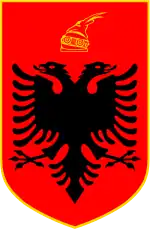| Cangonj Pass | |
|---|---|
| Gryka e Cangonjit | |
 Location in Albania | |
| Location | Cangonj, Korçë County, Albania |
| Range | Mount Moravë and Mount Ivan |
| Coordinates | 40°41′36.5676″N 20°54′30.495″E / 40.693491000°N 20.90847083°E |
Cangonj Pass (Albanian: Gryka e Cangonjit;[1] Albanian pronunciation: [ɡɾyːka e t͡sanˈɡɔɲit]) is a mountain pass located in the village of Cangonj, Korçë County, southeastern Albania. It is located between Mount Moravë and Mount Ivan south of Lake Prespa, and connects the Korçë Plain in the west with the Poloskë-Bilisht plain in the east. Crossed by the Devoll, the mountain pass was formed through the millennia by the excavating process of the flow of this river.[2]
In classical antiquity the name of the mountain pass was recorded as Tsangon,[3][4] which was traditionally a border area between Macedon and Illyria, being part of an important east-west communication route.[5][6]
History
The Tsangon Pass is mentioned by Arrian (2nd century CE) in The Anabasis of Alexander when describing Alexander's campaign in Illyria and the Siege of Pelium, which was waged in 335 BCE by Alexander the Great against Illyrians who revolted under the leadership of Cleitus, son of Bardylis, with the aid of Glaukias king of the Taulantii.[7] This mountain pass controlled one of the only two main west-east routes between Illyria and Macedonia. The other one was the route that became Via Egnatia in Roman times, which was located further north.[8][5] Alexander undertake his campaign in the Tsangon Pass to take Pelion ensuring the control of his western border, in order to protect Macedonia from Illyrian invasion before setting out for his eastern campaign. The northern route was already controlled by Macedon after Philip II's founding of Herakleia.[8]
The Tsangon Pass was likely used by Roman consul Sulpicius Galba to reach Macedonia from Illyria during the 199 BC military operations he undertook in the Second Macedonian War.[9][10] Tsangon was a mountain pass that linked the region of Lynkestis to southern Illyria.[11]
In World War II the pass was controlled by the advancing Greek forces at the initial stage of the Greco-Italian War (1940-1941).[12]
References
- ↑ Xholi & Vejsiu 2008, p. 1284
- ↑ Oikonomidis 2018, pp. 133, 134, 137
- ↑ Winnifrith 2002, p. 146: "Hammond talks about the lack of food, but there was food on the Poloskë plain east of the Tsangon pass, and Alexander, after an initial display of strength, was able to get food, although there were Illyrians on the mountains."
- ↑ King 2017, p. 148: "Winnifrith 2002: 143–148 suggests a site closer to the Tsangon Pass at Zvezdë. For the latter reference I am indebted to Jake Morton (personal correspondence); his recent autopsy leads him to favour Winnifrith’s suggestion, Zvezdë over Goricë and Selcë, which he believes is too far north."
- 1 2 Oikonomidis 2018, p. 137
- ↑ Morton 2017, p. 91
- ↑ Winnifrith 2002, pp. 147–148
- 1 2 Morton 2017, p. 91: "Alexander waged his campaign in at the Tsangon pass to control his western border before heading off on his extended eastern campaign. This makes sense as this pass controls one of the only two major east-west routes between Illyria and Macedonia, the other being the northern route that became the via Egnatia. Philip II's founding of Herakleia controlled Illyrian access west by the northern route; Alexander taking Pelium and the Tsangon pass controlled the southern route. ... Thus, by taking Pelium, Alexander could reasonably believe that he had protected Macedonia from Illyrian invasion and head off on his eastern campaign."
- ↑ Weber 1989, p. 84
- ↑ Morton 2017, p. 91: "Similarly, Sulpicius took Pelium to secure the Tsangon pass and the southern route east-west between Macedonian and Illyria and his control of the Genusus valley (by the allied Parthini and the earlier part of his 199 BC campaign) controlled the northernroute, again leaving the Metsovo pass as the next available option for the Macedonians to go west."
- ↑ Papazoglu 1988, p. 280: "Tous les passages débouchant dans la plaine pélagonienne ont été mis en ligne de compte. Même ceux qui reliaient la Lyncestide à l'Illyrie méridionale, comme le défilé de Tsangon, au Sud du lac de la Petite Prespa, ou bien le col de Djavato, entre Héraclée et Lychnidos.
- ↑ Lormier 2008, p. 41: "Les novembre 1940... Tsangoni".
Bibliography
- King, Carol J. (2017). Ancient Macedonia. Routledge. ISBN 9780415827287.
- Lormier, Dominique (2008). La Guerre Italo-Grecque: 1940-1941 (in French). Calmann-Lévy. ISBN 978-2-7021-4654-5.
- Morton, Jacob Nathan (2017). "Shifting Landscapes, Policies, And Morals: A Topographically Driven Analysis Of The Roman Wars In Greece From 200 Bc To 168 Bc". Publicly Accessible Penn Dissertations. University of Pennsylvania. 2484.
- Oikonomidis, Stavros (2018). "Διασυνοριακές οχυρές θέσειςμεταξύ Μακεδονίας και Ιλλυρίαςκατά την Πρώιμη Εποχή του Σιδήρου" [Fortresses of frontier between Macedonian and Illyria in the Early Iron Age]. Το Αρχαιολογικό Έργο στην Άνω Μακεδονία [To archaiologiko ergo stēn Anō Makedonia] - ΑΕΑΜ 3 (in Greek). Ainē. A: 133–145. ISBN 978-618-81407-3-8. ISSN 2241-0902.
- Papazoglu, Fanula (1988). Les villes de Macédoine à l'époque romaine (in French). Greece: Ecole française d'Athènes. ISBN 9782869580145.
- Weber, R. J. (1989). "The Taulantii and Pirustae in Livy's Version of the Illyrian Settlement of 167 B. C. : The Roman Record of Illyria". In Deroux, Carl (ed.). Studies in Latin Literature and Roman History. Vol. V. Latomus. pp. 66–93. ISBN 978-2-87031-146-2.
- Winnifrith, Tom J. (2002). Badlands-borderlands: a history of Northern Epirus/Southern Albania. London: Duckworth. ISBN 0-7156-3201-9.
- Xholi, Zija; Vejsiu, Ylli (2008). Fjalor enciklopedik shqiptar: H-M [Albanian Encyclopedic Dictionary: H-M]. Fjalor enciklopedik shqiptar (in Albanian). Vol. 2. Akademia e Shkencave e Shqipërisë. ISBN 978-9995610289.
